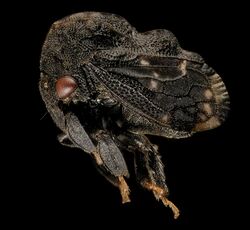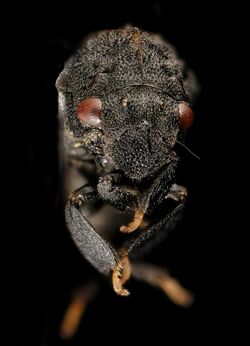Biology:Tylopelta gibbera
| Tylopelta gibbera | |
|---|---|

| |
| Scientific classification Error creating thumbnail: Unable to save thumbnail to destination
| |
| Domain: | Eukaryota |
| Kingdom: | Animalia |
| Phylum: | Arthropoda |
| Class: | Insecta |
| Order: | Hemiptera |
| Suborder: | Auchenorrhyncha |
| Family: | Membracidae |
| Genus: | Tylopelta |
| Species: | T. gibbera
|
| Binomial name | |
| Tylopelta gibbera (Stal, 1869)
| |
Tylopelta gibbera is a species of treehopper in the family Membracidae.[1][2][3] This insect has a range which extends from Guatemala into the central United States, although it is occasionally found in Canada.[4] Vibrational communication has been noted in this species, although there is discussion as to what exactly it is being used for.[5]
Life history
Tylopelta gibbera are sap feeders, and can be found on a variety of foliage, including members of Fagaceae (particularly Quercus) and Fabaceae. Females deposit eggs into the stems of woody plants, covering them with a waxy secretion to protect them from predators. Once the nymphs hatch, they are defended by ants who consume the honeydew that they exude as a digestive byproduct.[6]
Vibrational communication
Tylopelta gibbera have been observed using vibrational communication during mating displays. A male will produce a vibrational call that is transmitted through the stem of their host plant. This is done to elicit the response of a receptive female. In cases where there are more than one male, vibrational masking will take place where one male will overlap the call of the other, severely reducing female response rate[5].
References
- ↑ "Tylopelta gibbera species details". http://www.catalogueoflife.org/col/details/species/id/f0c9374ed0dd47ef271f673085bfeba9. Retrieved 2018-04-11.
- ↑ "Tylopelta gibbera Species Information". https://bugguide.net/node/view/311841. Retrieved 2018-04-11.
- ↑ "Tylopelta gibbera Overview". http://eol.org/pages/3697698/overview. Retrieved 2018-04-11.
- ↑ "Tylopelta gibbera". https://www.gbif.org/species/2022894. Retrieved 2018-04-11.
- ↑ 5.0 5.1 Legendre, Frédéric; Marting, Peter R.; Cocroft, Reginald B. (2012-02-01). "Competitive masking of vibrational signals during mate searching in a treehopper" (in en). Animal Behaviour 83 (2): 361–368. doi:10.1016/j.anbehav.2011.11.003. ISSN 0003-3472. https://mnhn.hal.science/mnhn-02520988/document.
- ↑ Lin, Chung‐Ping (2006-12-04). "Social behaviour and life history of membracine treehoppers". Journal of Natural History 40 (32–34): 1887–1907. doi:10.1080/00222930601046618. ISSN 0022-2933. https://doi.org/10.1080/00222930601046618.
Further reading
- Arnett, Ross H. Jr. (2000). American Insects: A Handbook of the Insects of America North of Mexico (2nd ed.). CRC Press. ISBN 0-8493-0212-9. https://books.google.com/books?id=DKzAmSDdLtsC.
External links
Wikidata ☰ Q10707062 entry
 |


